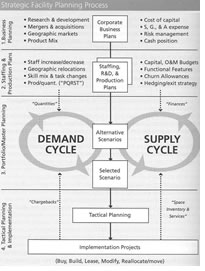
Adapted
from “Strategic Facility Planning,”
by Thomas O. McCune, AIA
 Architects
report that a leading concern for 2003 is identifying new markets/clients
(second only to “weak economy”), according to AIA Chief Economist
Kermit Baker, PhD, Hon. AIA. Offering new services to existing clients
is the most efficient marketing strategy. Therefore, as was illustrated
a dozen years ago, those firms that invest energy now to expand their
services intelligently have the best chance of prospering during hard
times.
Architects
report that a leading concern for 2003 is identifying new markets/clients
(second only to “weak economy”), according to AIA Chief Economist
Kermit Baker, PhD, Hon. AIA. Offering new services to existing clients
is the most efficient marketing strategy. Therefore, as was illustrated
a dozen years ago, those firms that invest energy now to expand their
services intelligently have the best chance of prospering during hard
times.
One service that clients want, even expect, from their architects is strategic planning for optimal use of their existing facilities. The following guidelines on how to expand your existing facility programming services into full-blown strategic facility planning services comes from chapter 17.4 of The Architect’s Handbook of Professional Practice, 13th edition.
A strategic facility plan answers the following questions about a corporation’s
real-estate portfolio for the foreseeable future:
• What kinds of space will the corporation need, how much, and where?
• When will the corporation need it?
• How will the corporation procure the space?
• What will it cost?
• What functions will go where?
• What is the sequence of transition?
• How will the corporation deal with unplanned changes in demand
for space?
Other issues include the internal business model, corporate identity and amenities, alternative officing, and productivity.
Necessary skill sets
Many of traditional architecture’s programming and design skills
apply to strategic facility planning. The most pertinent of these include
analyzing client goals and needs, identifying facts and constraints, generating
concepts, and developing space plans. Architecture firms that offer strategic-planning
services supplement these traditional architecture abilities with skills
and training from related fields, such as:
• Finance—financial analysis, forecasting, benchmarking competing
companies, demographics
• Law—permits, entitlements, restrictions
• Industrial engineering—materials handling, plant layout,
throughput analysis, capacity planning
• Civil engineering—transportation planning, site analysis,
drainage, utilities
• Landscape architecture—site planning, site selection
• Real estate—site selection, costs, demographics
• MEP engineering—utilities, network telecommunications.
 Supply
and demand
Supply
and demand
In its simplest terms, strategic facility planning entails matching supply
of useable space to the demand for it. Finding this balance over a three-year
projection is anything but simple.
Regarding demand, a client might need to develop the corporate strategy for growth and market penetration, head-count forecasts by task type and location, production and sales projections, current and desired strategic partnerships, possible officing alternatives, and industry forecasts.
The supply of space depends on both the market and the client’s ability to afford new or expanded space. The ability of the facility planner to find cost-efficient alternatives and strategies to increase the client’s competitive position defines his or her worth. Elements to consider include allowable density, proximity to the workforce and infrastructure, initial cost, tax incentives, resale value, land-use restrictions, site access, and proximity to competitors.
As illustrated in the chart above, the analysis of demand and supply factors leads to the development of alternative scenarios from which the client selects. At that point, the planner/consultant firm has positioned itself ideally for carrying through with implementation.
Copyright 2003 The American Institute of Architects. All rights reserved.
![]()
| Tom McCune is CEO of AE Pragmatics, Inc, serving Silicon Valley tech companies. He chaired the AIA Corporate Architects Professional Interest Area in 2000. The Architect’s Handbook of Professional Practice, 13th edition, Part 4, presents 30 services architects can expand into in three areas: predesign, design/construction, and operations/maintenance. Each service section contains guidance on client demand, the knowledge and skills required to provide the service, and the process tasks involved. To order copies of the Architect’s Handbook for your next firm-growth strategy meeting, visit the AIA Bookstore site or call 800-242-3837, option 4. |
|